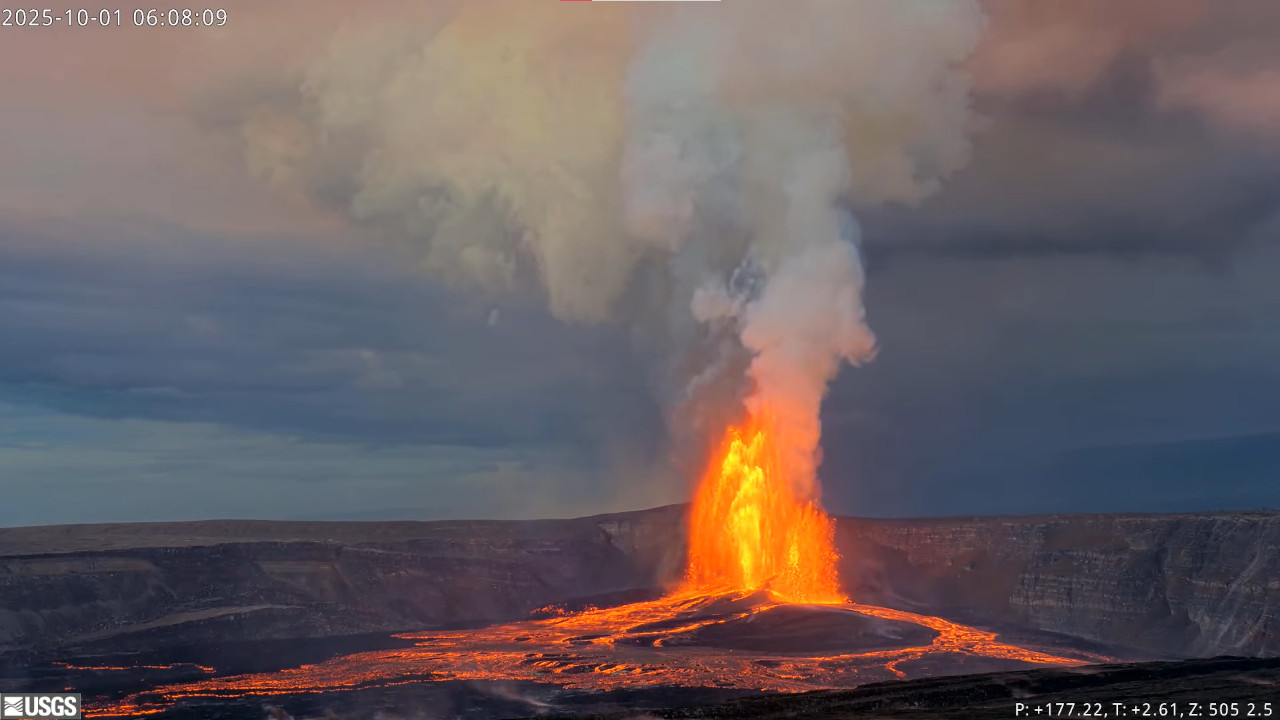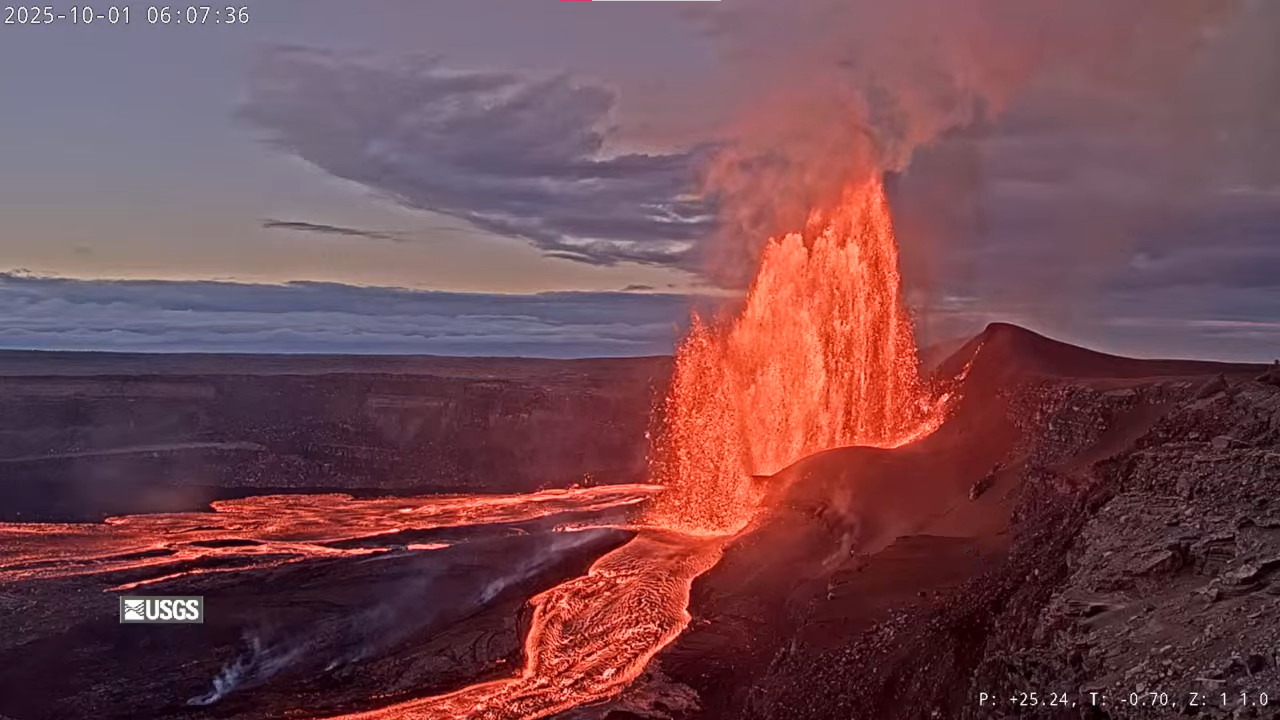UPDATE – (8:17 a.m. HST) – Episode 34 of the ongoing Kīlauea summit eruption ended abruptly at 7:03 a.m. HST on October 1 after just over 6 hours of continuous fountaining. Scientists with the USGS Hawaiian Volcano Observatory reported:
The north vent began continuous fountaining at 12:53 a.m. HST on October 1, and stopped erupting at approximately 7:03 a.m. HST, marking the end of the episode. The south vent erupted between 1:45-7:00 a.m. HST. Lava fountains from the north vent were inclined to the northeast, while lava fountains from the south vent were vertical and reached up to an estimated 1300 ft (400 m) during this episode. Approximately 8.9 million cubic yards (2.5 billion gallons) were erupted during episode 34. Volcanic gas emissions have greatly decreased. Lava flows from this episode on the floor of Halemaʻumaʻu within the southern part of Kaluapele (Kīlauea caldera) may continue to exhibit slow movement or incandescence as they cool and solidify over the coming days.
The Uēkahuna tiltmeter (UWD) recorded about 26 microradians of deflationary tilt during this episode. The end of the eruption was coincident with a rapid change from deflation to inflation at the summit and a decrease in seismic tremor intensity.
FIRST REPORT
(BIVN) – High lava fountains are erupting at the summit of Kīlauea volcano, as Episode 34 is underway.
For the first time since some of the earlier episodes in this eruption, two high lava fountains are erupting simultaneously at the north and south vents.
The USGS Volcano Alert Level for Kīlauea remains at WATCH and the Aviation Color Code is ORANGE. All activity is confined to the summit caldera within Hawaiʻi Volcanoes National Park.
The National Weather Service in Honolulu also issued a Special Weather Statement, warning periods of ashfall are likely in certain areas on Hawaiʻi island.
“Low level trade winds will push ash toward the southwest, and any ash fallout will likely occur over the Kaʻū District and Highway 11 southwest of the town of Volcano,” the forecasters wrote. “This includes the communities of Pahala, Wood Valley, Naʻalehu, Ocean View, Miloliʻi and Honaunau, Captain Cook and Kealakekua.”
“With winds spreading ash in the same direction, repeated eruptions will lead to a heavier buildup of ash,” the NWS continued. “In addition, any ash deposited over the last several days will likely be picked up by local winds, contributing to dusty conditions.”
Exposure to ash is known to be an eye and respiratory irritant, forecasters said, recommending that “those with respiratory sensitivities should take extra precaution to minimize exposure.”
Although the federal government is shutdown, the USGS Hawaiian Volcano Observatory was able to distribute a Status Report at the onset of Episode 34, followed by a Volcanic Activity Notice and Aviation Notice. However, the USGS has not posted any updates to social media platforms, such as Facebook and X, since the midnight shutdown began.
On the USGS HVO website, an new message posted at the top of the page reads: “Because of the federal government shutdown, www.usgs.gov is not being updated and the agency will not be able to respond to inquiries until appropriations are enacted.”
From the USGS HVO notice written at 1:13 a.m. HST:
Episode 34 of the ongoing Halemaʻumaʻu eruption began at 12:53 a.m. HST on October 1. Low lava fountains, approximately 30 feet (10 meters) high began feeding lava flows from the north vent at 11:43 p.m. HST on September 30. Fountains began to increase in size and volume along with the onset of deflation at 12:53 a.m. HST October 1. Fountains are currently up to 330 feet or 100 meters and inclined slightly to the northeast. Past episodes have produced incandescent lava fountains over 1000 feet (300 meters) high with eruptive plumes up to 20,000 feet (6000 meters) above ground level. According to the National Park Service and the USGS SDH monitoring station, winds are blowing moderately from the northeast direction, which suggests that volcanic gas emissions and volcanic material may be distributed to the southwest of Halemaʻumaʻu.
Episode 34 was preceded by over 120 gas pistoning events producing small, sporadic spatter fountains 10 feet (3 meters) and many resulting in short overflows. These events began at approximately 9:47 p.m. September 28 and continued to increase in frequency and intensity until they became rhythmic at 1:30 p.m., September 29. The rhythmic gas pistons continued past midnight, but produced only 10 overflows in 100 events by 6:30 a.m. HST. Gas pistoning continued and magma remained high in the north vent, and additional overflows occurred from 2:22 p.m. to 6:50 p.m. HST on September 30. Sustained overflow and low-level fountaining began at 11:43 p.m. HST on September 30 with 30 foot (10 meter) fountains. Fountaining became began increasing in height to over 60 feet (20 meters) and ground deformation of Kīlauea summit switched from inflation to deflation at approximately 12:53 a.m. HST on October 1, indicating the episode 34 has begun. Fountains from the north vent are currently up to 330 feet or 100 meters and inclined slightly to the northeast, feeding lava flows within Halemaʻumaʻu crater.
Inflationary tilt reached 18 microradians since the end of the last episode. Seismic tremor began increasing and tilt at UWD switched from inflationary to deflationary at about 12:53 a.m. HST.



by Big Island Video News6:57 am
on at
STORY SUMMARY
HAWAIʻI VOLCANOES NATIONAL PARK - The high fountain phase of Episode 34 is underway at the summit of Kīlauea volcano.